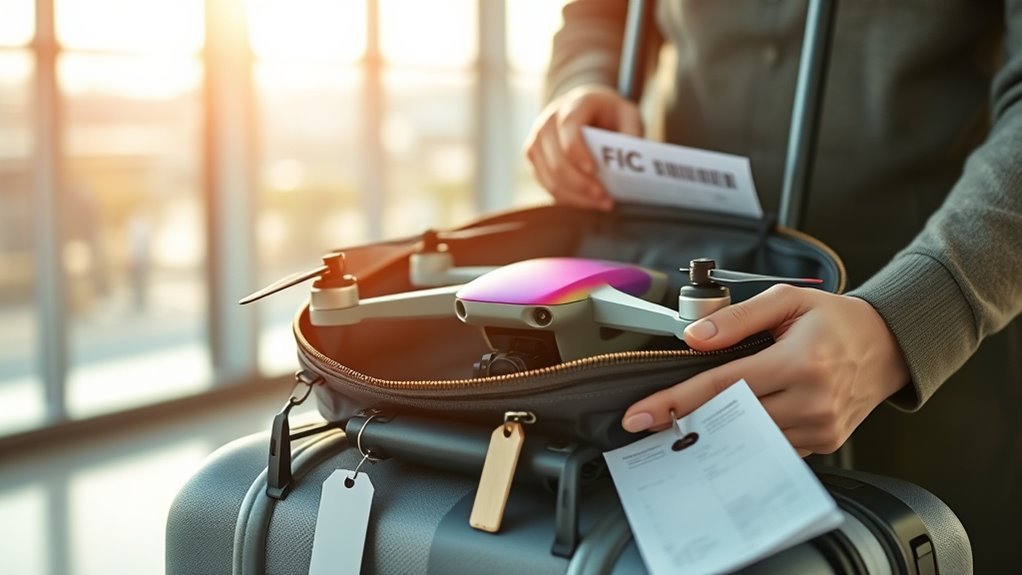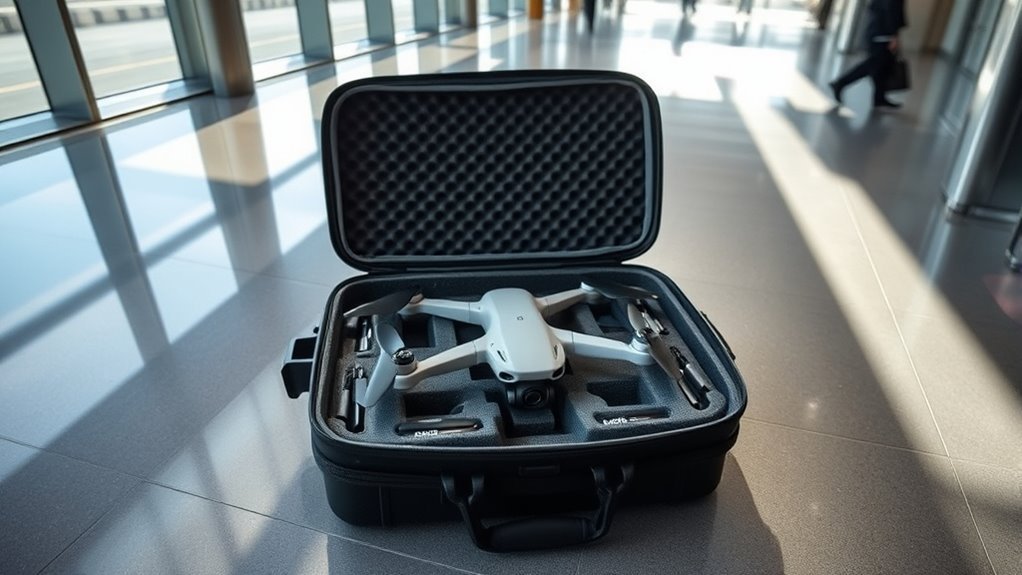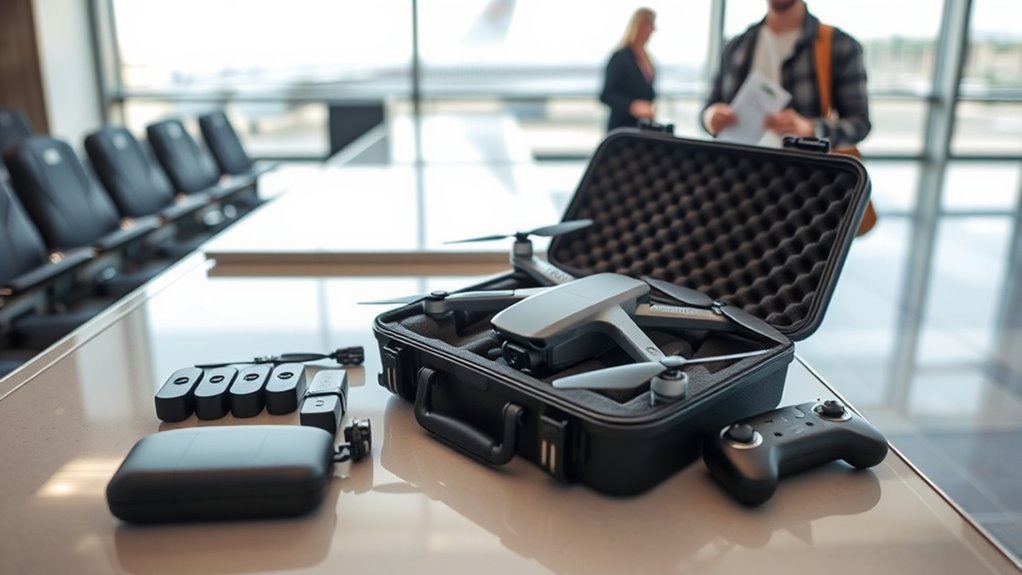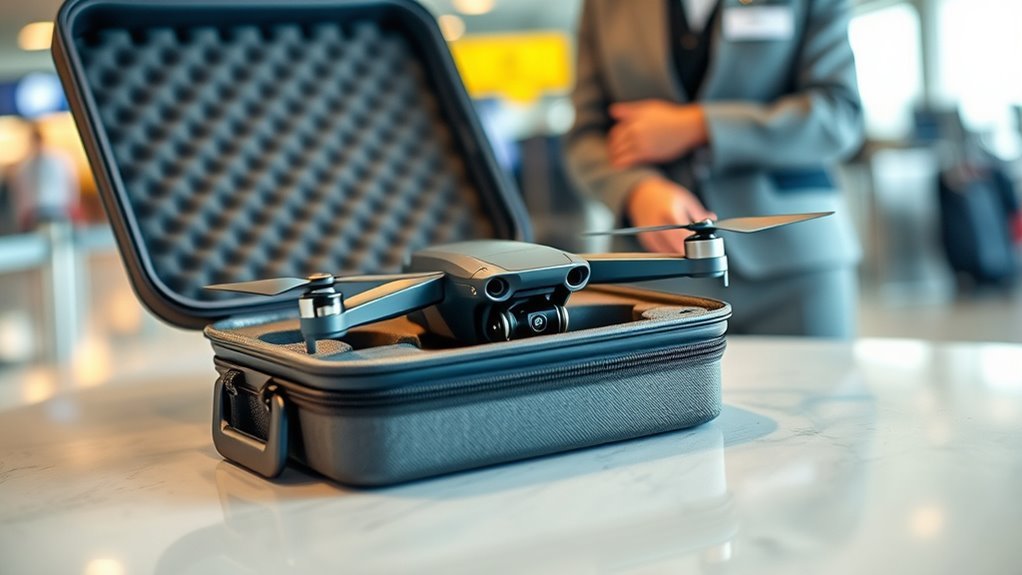To safely bring a drone on an airplane, check your airline’s regulations on size and battery limits. Pack your drone in a sturdy case, removing accessories and cushioning them well. Keep batteries stored in carry-on luggage and at a partial charge (30-50%) to comply with safety guidelines. Carrying your drone guarantees it’s within reach. Arrive early for a smoother security screening and have your drone registration handy. You’ll learn more essential tips as you explore this topic further.
Understanding Airline Regulations

When you’re planning to bring a drone on an airplane, it’s crucial to understand airline regulations to avoid any hassles. Different airlines have unique rules regarding drone size, often dictating weight and dimensions for carry-on and checked baggage. Before you fly, check the specific airline’s guidelines. Additionally, international regulations can vary greatly; some countries may restrict drone use entirely or require special permits. Familiarizing yourself with these rules can save you from unexpected issues at security checkpoints or upon arrival. Always verify your drone is compliant with both the airline and destination regulations. This freedom to travel with your drone hinges on your preparation, so take the time to research and enjoy your aerial adventures.
Packing Your Drone for Travel

After confirming your airline and destination regulations, it’s time to focus on packing your drone securely for travel. Start by using a sturdy case designed specifically for drones. This protects your equipment and keeps it organized. Remove any drone accessories, like propellers and cameras, and pack them separately using soft packing materials to prevent damage. Consider using bubble wrap or foam inserts for extra cushioning. Verify everything fits snugly in your case to minimize movement during transit. Label your case clearly, and keep any essential documents handy. By taking these precautions, you’ll safeguard your drone while enjoying the freedom to travel with it. Remember, a little preparation goes a long way in verifying a smooth journey. Additionally, ensure your drone’s battery performance complies with airline regulations, especially since some batteries may have restrictions on capacity and quantity.
Battery Safety and Guidelines

Since lithium batteries power most drones, it’s crucial to understand the safety guidelines for transporting them on an airplane. Always check the battery types you’re carrying, as different capacities have specific regulations. Generally, batteries over 100 watt-hours (Wh) might not be allowed. For safety, keep your batteries at a partial charge—around 30-50%—before travel. This helps reduce the risk of fire during transport. Additionally, follow charging precautions: use only manufacturer-approved chargers and avoid charging batteries in confined spaces. Store batteries in protective cases to prevent short-circuiting. Finally, always keep your batteries in your carry-on luggage, as this guarantees you’re prepared and increases safety. Being informed and cautious helps you enjoy your drone adventures without complications.
Carry-On vs. Checked Luggage
While you might be tempted to check your drone in with your luggage, it’s generally safer and more convenient to bring it as a carry-on. Carry-on advantages include having your drone within reach, reducing the risk of damage, and keeping an eye on it throughout your journey. Plus, you won’t have to worry about lost luggage or delays.
Checked luggage limitations pose serious concerns, especially regarding battery regulations and potential mishandling. Airlines may have specific guidelines, and not all check-in systems are equipped to handle delicate equipment. By choosing to carry your drone, you guarantee its safety and maintain your freedom to travel without stress. Ultimately, keeping your drone close is the best way to protect your investment. Additionally, being aware of signal attenuation can help you understand the potential limitations of your drone’s capabilities during flights in different environments.
Tips for Smooth Security Screening
Bringing your drone as a carry-on can make security screening smoother. Follow these screening tips to breeze through security procedures:
| Tip | Benefit | Emotion |
|---|---|---|
| Remove drone battery | Quicker inspection | Peace of mind |
| Use a dedicated bag | Organized approach | Freedom to explore |
| Arrive early | Reduce stress | Calm and collected |
Additionally, be aware of your drone’s flight time capabilities, as certain models may have restrictions that could affect your travel plans. It’s also essential to ensure that your drone is registered properly to avoid any legal issues during your travels.
Frequently Asked Questions
Can I Take My Drone on International Flights?
Yes, you can take your drone on international flights, but you’ll need to check each country’s regulations and customs requirements. Some places have strict rules, so it’s best to research beforehand to avoid issues.
What Should I Do if My Drone Gets Damaged During Travel?
If your drone gets damaged during travel, document the damage with photos. Check your travel insurance for coverage on drone repair, and consider contacting a local repair service to get it fixed quickly.
Are There Size Restrictions for Drones on Airplanes?
Yes, there’re size restrictions for drones on airplanes. Check airline-specific drone regulations and travel tips to guarantee your drone fits within carry-on limits. Staying informed will help you travel smoothly without hassle.
Can I Use My Drone During the Flight?
You can’t use your drone during the flight due to strict drone regulations. In-flight usage is prohibited, as it could interfere with aircraft systems. Always check airline policies to stay informed and compliant.
What Happens if My Drone Is Confiscated at Security?
About 15% of travelers face drone confiscation at security checkpoints. If that happens, you’ll need to follow the drone retrieval process, which often involves specific security checkpoint procedures, and may require patience and documentation.

